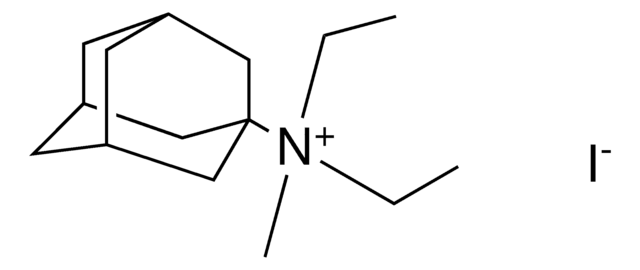1.04727
Isooctane
for analysis EMSURE® ACS,Reag. Ph Eur
Synonyme(s) :
2,2,4-Triméthylpentane, 2,2,4-Triméthylpentane, Isobutyltriméthylméthane, iso-Octane, Isooctane
About This Item
Produits recommandés
Qualité
ACS reagent
Niveau de qualité
Agence
reag. Ph. Eur.
Densité de vapeur
3.9 (vs air)
Pression de vapeur
41 mmHg ( 21 °C)
Gamme de produits
EMSURE®
Pureté
≥99.5% (GC)
Forme
liquid
Température d'inflammation spontanée
745 °F
Puissance
>2500 mg/kg LD50, oral (Rat)
Limite d'explosivité
6 %
Impuretés
≤0.0003 meq/g Acidity
≤0.005% Sulfur compounds (as S)
≤0.01% Water
Résidus d'évap.
≤0.001%
Couleur
APHA: ≤10
Transmittance
250-420 nm, ≥98%
Indice de réfraction
n20/D 1.391 (lit.)
pH
7
Point d'ébullition
98-99 °C (lit.)
Pf
−107 °C (lit.)
Température de transition
flash point -12 °C
Densité
0.692 g/mL at 25 °C (lit.)
Traces de cations
Al: ≤0.00005%
B: ≤0.000002%
Ba: ≤0.00001%
Ca: ≤0.00005%
Cd: ≤0.000005%
Co: ≤0.000002%
Cr: ≤0.000002%
Cu: ≤0.000002%
Fe: ≤0.00001%
Mg: ≤0.00001%
Mn: ≤0.000002%
Ni: ≤0.000002%
Pb: ≤0.00001%
Sn: ≤0.00001%
Zn: ≤0.00001%
Température de stockage
2-30°C
Chaîne SMILES
CC(C)CC(C)(C)C
InChI
1S/C8H18/c1-7(2)6-8(3,4)5/h7H,6H2,1-5H3
Clé InChI
NHTMVDHEPJAVLT-UHFFFAOYSA-N
Vous recherchez des produits similaires ? Visite Guide de comparaison des produits
Application
- Behavior of acetyl modified amino acids in reverse micelles: a non-invasive and physiochemical approach.: This study utilizes isooctane in reverse micelles to explore the behavior of acetyl modified amino acids. The findings emphasize isooctane′s role in facilitating non-invasive and physiochemical analyses, highlighting its importance in analytical chemistry and biochemical studies (Mehta et al., 2007).
- Nonionic surfactants: a key to enhance the enzyme activity at cationic reverse micellar interface.: The research investigates the use of isooctane in forming cationic reverse micelles with nonionic surfactants to enhance enzyme activity. Isooctane′s effectiveness in this context underscores its value in biocatalysis and enzymatic studies (Shome et al., 2007).
- Lecithin organogels used as bioactive compounds carriers. A microdomain properties investigation.: This study explores the application of isooctane in lecithin organogels for carrying bioactive compounds. Isooctane′s role in stabilizing the microdomains within the organogels is crucial for their effectiveness in drug delivery systems (Avramiotis et al., 2007).
- Switching electrical conductivity in an AOT-isooctane-water microemulsion through photodimerization of solubilized N-methyl-2-quinolone.: This research demonstrates the use of isooctane in AOT-water microemulsions to switch electrical conductivity via photodimerization. The study highlights isooctane′s utility in developing responsive materials for advanced chemical and physical applications (Bufe and Wolff, 2006).
- Photochromism of crown ethers with incorporated azobenzene moiety.: Isooctane is utilized in studying the photochromism of crown ethers with azobenzene moieties. The findings underscore isooctane′s role in facilitating the investigation of photoresponsive materials, relevant to materials science and photochemistry (Janus and Sworakowski, 2005).
Remarque sur l'analyse
Identité (IR) : conforme
Couleur : ≤ 10 Hazen
Acidité : ≤ 0,0003 meq/g
Densité (d 20 °C/20 °C) : 0,691 - 0,696
Indice de réfraction (n 20/D) : 1,391 - 1,393
Plage d'ébullition (98-100 °C) : ≥ 95 % (v/v)
Composés soufrés (exprimés en S) : ≤ 0,005 %
Substances facilement carbonisables : conforme
Transmission (entre 250 nm et 420 nm) : ≥ 98 %
Al (aluminium) : ≤ 0,00005 %
B (bore) : ≤ 0,000002 %
Ba (baryum) : ≤ 0,00001 %
Ca (calcium) : ≤ 0,00005 %
Cd (cadmium) : ≤ 0,000005 %
Co (cobalt) : ≤ 0,000002 %
Cr (chrome) : ≤ 0,000002 %
Cu (cuivre) : ≤ 0,000002 %
Fe (fer) : ≤ 0,00001 %
Mg (magnésium) : ≤ 0,00001 %
Mn (manganèse) : ≤ 0,000002 %
Ni (nickel) : ≤ 0.000002 %
Pb (plomb) : ≤ 0,00001 %
Sn (étain) : ≤ 0.00001 %
Zn (zinc) : ≤ 0,00001 %
Résidu d′évaporation : ≤ 0,001 %
Eau : ≤ 0,01 %
Conforme à ACS, réactif Ph Eur
Informations légales
Mention d'avertissement
Danger
Mentions de danger
Conseils de prudence
Classification des risques
Aquatic Acute 1 - Aquatic Chronic 1 - Asp. Tox. 1 - Flam. Liq. 2 - Skin Irrit. 2 - STOT SE 3
Organes cibles
Central nervous system
Code de la classe de stockage
3 - Flammable liquids
Classe de danger pour l'eau (WGK)
WGK 2
Point d'éclair (°F)
10.4 °F - closed cup
Point d'éclair (°C)
-12 °C - closed cup
Certificats d'analyse (COA)
Recherchez un Certificats d'analyse (COA) en saisissant le numéro de lot du produit. Les numéros de lot figurent sur l'étiquette du produit après les mots "Lot" ou "Batch".
Déjà en possession de ce produit ?
Retrouvez la documentation relative aux produits que vous avez récemment achetés dans la Bibliothèque de documents.
Les clients ont également consulté
Notre équipe de scientifiques dispose d'une expérience dans tous les secteurs de la recherche, notamment en sciences de la vie, science des matériaux, synthèse chimique, chromatographie, analyse et dans de nombreux autres domaines..
Contacter notre Service technique










